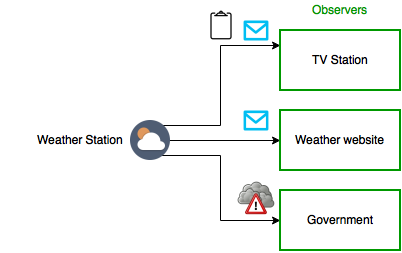Java EE 8 - CDI 2.0: Events and Observers
Observable Event example with CDI 2.0 (Java EE 8)
Code source: GitHub
- CDI website: https://www.cdi-spec.org/
- CDI documentation: https://docs.jboss.org/cdi/spec/2.0-PFD2/cdi-spec.html
- CDI specifications: https://www.jcp.org/en/jsr/detail?id=365
With Java EE 8 CDI will receive a major upgrade. Between the new major features we can find:
- Observer ordering
- Asynchronous event
In this demo we will build a small example using these new features. You can find the code on GitHub.
Weather station : requirements
In this example we simulate a Weather station that has to notify multiple observer every time the weather changes.
There are 3 clients (Observers):
- The TV channel that want to be alerted for every change. The communication has to be done immediately via a predefined channel and when possible (best effort) a detailed report has to be sent via mail (preparing a mail requires time (blocking activity).
- The official Weather website has to be updated immediately, it doesn’t need a detailed report (more twitter style communication).
- The emergency services of the government need to be alerted only in case of catastrophic events (flood etc). The communication has to be immediate.
Technical implementation
The clients are Observers that need to be notified when an event occours. The TV Channel Observer:
@Stateless
public class TVChannelsChangeObserver {
public void notifyTVChannel(@Observes WeatherEvent weatherEvent) {
weatherEvent.addEvent("TV Channel informed about the " + weatherEvent.getCurrentWeather());
}
public void sendDetailedReport(@ObservesAsync WeatherEvent weatherEvent) {
weatherEvent.addEvent("ASYNCH : TV Channel, detailed email report sent");
}
}
The class has two methods: one annotated with @Observes receives the synchronous WeatherEvent (notifyTVChannel), one annotated with @ObservesAsynch receives the async WeatherEvent.
WeatherEvent is a simple POJO that can be used to fire an Event.
public class WeatherEvent {
private String currentWeather;
public WeatherEvent(String currentWeather) {
this.currentWeather = currentWeather;
}
}
The Emergency Services have to be alerted only in case of ‘emergency‘, in this case we can use a @Qualifier to filter the notification received:
public void sendAlarm(@Observes @WeatherType(value = "emergency") WeatherEvent weatherEvent) {
weatherEvent.addEvent("EMERGENCY communication sent!!! They will come soon!");
}
How to fire the events
To fire the event we need to inject the WeatherEvent 2 times in our service or controller class. One time for the sync Event, the second time for the async Event (with the @Qualifier WeatherType).
@Inject
Event<WeatherEvent> weatherEvent;
@Inject
@WeatherType(value = "emergency")
Event<WeatherEvent> emergencyEvent;
If we receive an emergency alert we fire the Event of type ’emergency’ (emergencyEvent), otherwise we fire a simple ‘weatherEvent’.
WeatherEvent weatherSubject = new WeatherEvent(weatherRequestBean.getWeather());
if (weatherRequestBean.getEmergency()) {
emergencyEvent.fire(weatherSubject);
emergencyEvent.fireAsync(weatherSubject);
} else {
weatherEvent.fire(weatherSubject);
weatherEvent.fireAsync(weatherSubject);
}
The container automatically call the Observers interested:
- emergencyEvent.fire(weatherSubject) : no Observer
- emergencyEvent.fireAsync(weatherSubject) : EmergencyObserver, TVChannelObserver, WeatherWebsiteObserver
- emergencyEvent.fire(weatherSubject) : TVChannelObserver, WeatherWebsiteObserver
- emergencyEvent.fireAsync(weatherSubject) : TVChannelObserver
The advantage of this solution is that you can add new Observers (e.g. newspaper, Twitter etc.) without any change to the application logic.
How to test it
You can go on https://javademo.io/cdi-weather and play with it 🙂

